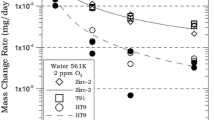Abstract
Pressurized water reactors circulate high-temperature water that slowly corrodes Inconel and stainless steel system surfaces, and the nickel/iron based corrosion products deposit in regions of the fuel where sub-cooled nucleate boiling occurs. The deposited corrosion products, called ‘crud’, can have an adverse impact on fuel performance. Boron can concentrate within the crud in the boiling regions of the fuel leading to a phenomenon known as axial offset anomaly (AOA). In rare cases, fuel clad integrity can be compromised because of crud-induced localized corrosion (CILC) of the zirconium-based alloy. Westinghouse and the Electric Power Research Institute have committed to understanding the crud transport process and develop a risk assessment software tool called boron-induced offset anomaly (BOA) to avoid AOA and CILC. This paper reviews the history of the BOA model development and new efforts to develop a micro-scale model called MAMBA for use in the Consortium for Advanced Light Water Reactor Simulation (CASL) program.
Similar content being viewed by others
References
PWR Axial Offset Anomaly Guidelines (Palo Alto, CA: EPRI, 1999), TR-110070.
Pressurized Water Reactor Primary Water Chemistry Guidelines: Volume 1, Revision 6 (Palo Alto, CA: EPRI, 2007), 1015018.
R. Riess, Nuclear Technology, 29(2) (1976), pp. 153–159.
R. Tropasso, J. Willse, and B. Cheng, “Crud-Induced Cladding Corrosion Failures in TMI-1 Cycle 10” (Paper presented at the 2004 International Meeting on LWR Fuel Performance, Orlando, Florida, September Coolant Flow Transport Rates Solubles CS i Particulates CP i Vapor (SNB) CILC CIPS CRUD CM i Figure 11. Flowchart of the MPO crud model (MAMBA) showing the relationship between the different phases, interfaces, and sub-models. The Ci represent the concentrations of the various elemental species in each phase where i= Ni, Fe, B, Li, Zn, Zr, Cr, Co. 19–22, 2004).
Fuel Reliability Guidelines: PWR Fuel Cladding Crud and Corrosion (Palo Alto, CA: EPRI, 2008). 1015499.
Boron-Induced Offset Anomaly (BOA) Risk Assessment Tool, Version 1.0 (Palo Alto, CA: EPRI, 2003), 1003211.
Boron-Induced Offset Anomaly Risk Assessment Tool, Version 2.0 (Revision 2) (Palo Alto, CA: EPRI, 2008), 1018347.
Boron-induced Offset Anomaly Risk Assessment Tool, Version 3.0 (Palo Alto, CA: EPRI, 2010), 1021227.
J.R. Secker et al., “BOB: An Integrated Model for Predicting Axial Offset Anomaly” (Paper presented at the TOPFUEL Conference, Stockholm, Sweden, May 2001).
M.Y. Young and J.R. Secker, “The Effect of Corrosion Product Deposition on Fuel Management” (Paper presented at the Advances in Nuclear Fuel Management III Conference, Hilton Head Island, South Carolina, USA, October 2003).
Rootcause Investigation of Axial Power Offset Anomaly (Palo Alto, CA: EPRI, 1997). TR-108320.
J.R. Bosma et al., “A Comprehensive Method for Assessing Fuel Performance Risks Due to Crud Deposition” (Paper presented at the 2004 International Meeting on LWR Fuel Performance, Orlando, Florida, September 2004).
G. Wang, M.Y. Young, W.A. Byers, and M.A. Krammen, “Methods to Reduce CIPS/CILC Risk for the Zero Fuel Failure by 2010 Initiative” (Paper presented at the 18th International Conference on Nuclear Engineering, ICONE18-30149, Xi’an, China, May 17–21, 2010).
J. Robertson, Corros. Sci., 32 (1991), p. 443.
W.A. Byers and J. Deshon, “Evaluation of Fuel Clad Corrosion Product Deposits and Circulating Corrosion Products in PWRs” (Palo Alto, CA: EPRI and Pittsburgh, PA: Westinghouse Electric Company, 2004), 1009951.
R.V. Macbeth, R. Trenberth, and R.W. Wood, “An Investigation into the Effect of Crud Deposits on Surface temperature, Dry-out and Pressure Drop, with Forced Convection Boiling of Water at 69 Bar in an Annular Test Section,” Report AEEW-R705 (Abingdon, OX, UK: United Kingdom Atomic Energy Authority, 1971).
P. Cohen, “Heat and Mass Transfer for Boiling in Porous Deposits with Chimneys,” AIChE Symposium Series, 70(138) (1974), pp. 71–80.
B.K. Kendrick, M.P. Short, C.R. Stanek, and R.B. Lowrie, “Material Framework for CRUD Test Problem,” CASL/MPO report and references therein (2011).
C.W. Bale, P. Chartrand, S.A. Degterov, G. Eriksson, K. Hack, R. Ben Mahfoud, J. Melancon, A.D. Pelton, and S. Petersen, “FactSage Thermochemical Software and Databases,” Calphad, 26(2) (2002), pp. 189–228.
Author information
Authors and Affiliations
Corresponding author
Rights and permissions
About this article
Cite this article
Deshon, J., Hussey, D., Kendrick, B. et al. Pressurized water reactor fuel crud and corrosion modeling. JOM 63, 64–72 (2011). https://doi.org/10.1007/s11837-011-0141-z
Published:
Issue Date:
DOI: https://doi.org/10.1007/s11837-011-0141-z



